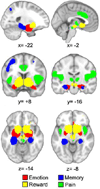Chronic pain: the role of learning and brain plasticity
- PMID: 23603439
- PMCID: PMC4922795
- DOI: 10.3233/RNN-139003
Chronic pain: the role of learning and brain plasticity
Abstract
Based on theoretical considerations and recent observations, we argue that continued suffering of chronic pain is critically dependent on the state of motivational and emotional mesolimbic-prefrontal circuitry of the brain. The plastic changes that occur within this circuitry in relation to nociceptive inputs dictate the transition to chronic pain, rendering the pain less somatic and more affective in nature. This theoretical construct is a strong departure from the traditional scientific view of pain, which has focused on encoding and representation of nociceptive signals. We argue that the definition of chronic pain can be recast, within the associative learning and valuation concept, as an inability to extinguish the associated memory trace, implying that supraspinal/cortical manipulations may be a more fruitful venue for adequately modulating suffering and related behavior for chronic pain. We briefly review the evidence generated to date for the proposed model and emphasize that the details of underlying mechanisms remain to be expounded.
Figures


References
-
- Apkarian AV, Bushnell MC, Treede RD, Zubieta JK. Human brain mechanisms of pain perception and regulation in health and disease. Eur J Pain. 2005;9(4):463–484. - PubMed
Publication types
MeSH terms
Grants and funding
LinkOut - more resources
Full Text Sources
Other Literature Sources
Medical
Molecular Biology Databases

